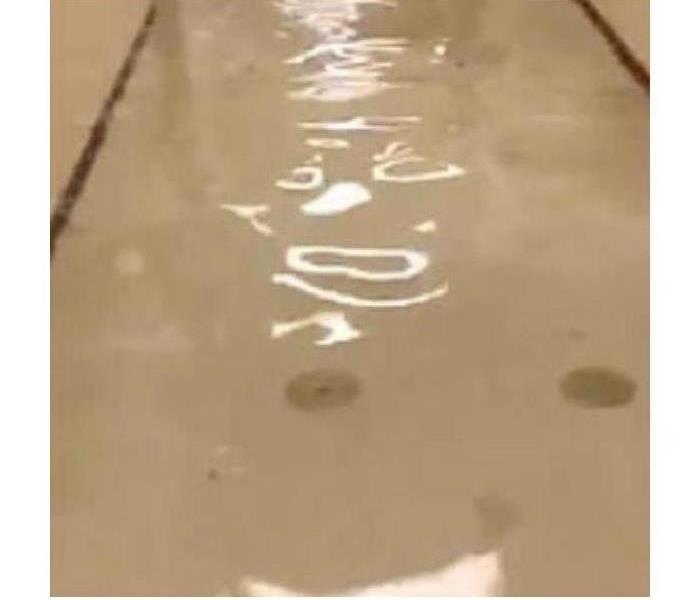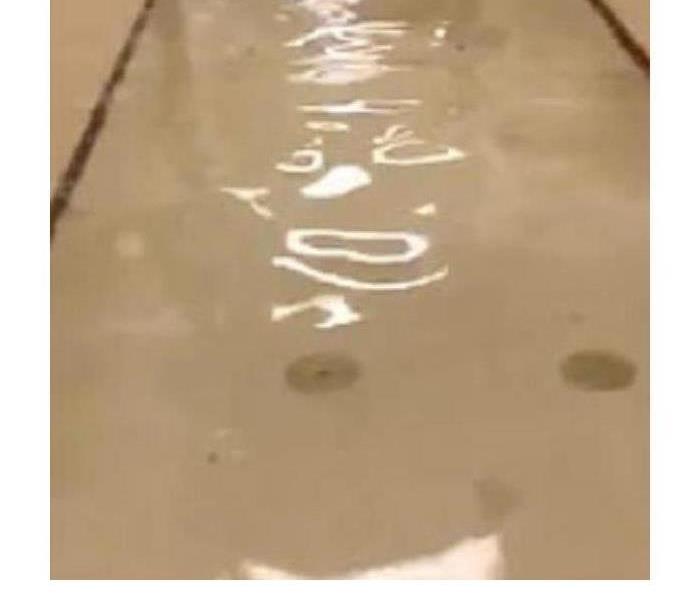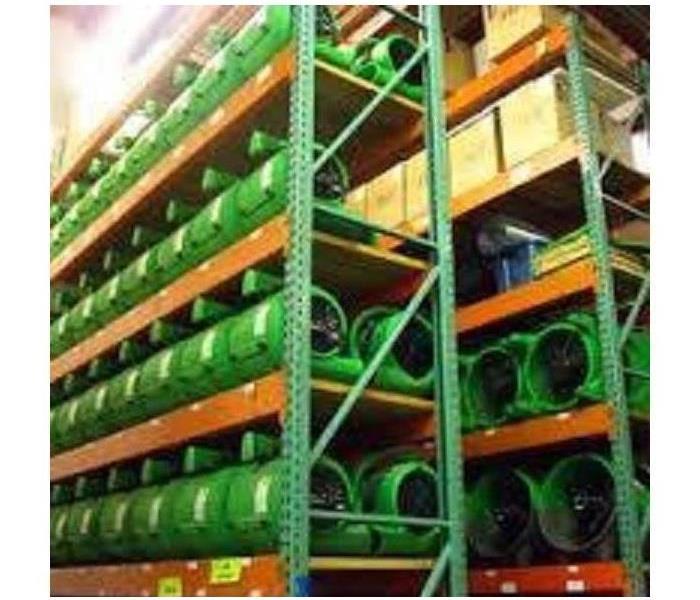Recent Posts
Restoring Businesses in Santa Rosa County with Expert Commercial Restoration Services
11/5/2024 (Permalink)
When disaster strikes, the impact on your business can be devastating. From water damage to fire destruction, these events can halt operations and threaten your livelihood. At SERVPRO©, we understand the urgency and complexity of restoring commercial properties quickly and effectively. Our specialized Commercial Restoration Services are designed to get your business back to normal in record time, minimizing downtime and ensuring a safe, seamless recovery.
Why Choose SERVPRO© of Santa Rosa County for Your Commercial Restoration Needs?
1. We Are Faster to Any Size Disaster
Every second matters when dealing with damage to your commercial property. At SERVPRO, we are committed to responding swiftly and efficiently, whether it’s a small cleanup job or a large-scale disaster. Our strategic location in Santa Rosa County ensures a rapid response, so your business can resume operations as soon as possible.
- 24/7 Emergency Service: Our team is available around the clock to address your emergencies, offering you peace of mind day or night.
- Locally Owned and Operated: As members of the Santa Rosa County community, we care deeply about our local businesses and take pride in offering personalized and attentive service.
Comprehensive Commercial Restoration Services
SERVPRO offers a wide range of Commercial Restoration Services tailored to meet the unique needs of your business. From water and fire damage to mold remediation, our highly trained technicians are prepared to tackle any challenge.
Water Damage Restoration
Water damage can occur from flooding, burst pipes, or even severe storms. It can lead to severe structural damage and health risks if not addressed immediately. Our team uses advanced drying and dehumidification equipment to remove water and prevent further damage.
- Advanced Water Extraction Equipment: We use industrial-grade pumps and vacuums to remove large volumes of water quickly.
- Moisture Detection: We utilize infrared cameras and hygrometers to locate hidden moisture and ensure thorough drying.
- Document and Electronic Restoration: For offices and businesses with critical files, our team can help salvage important documents and data.
Fire Damage Restoration
The aftermath of a fire can be overwhelming, leaving behind charred debris, smoke odors, and damaged structures. SERVPRO provides comprehensive fire restoration services to clean, restore, and deodorize your business.
- Soot and Smoke Removal: We use advanced equipment to remove smoke and soot from surfaces, ensuring a safe and clean environment.
- Content Cleaning and Restoration: Our experts are skilled at restoring business equipment, furniture, and inventory whenever possible.
- Structural Repairs: From minor fixes to major construction, we handle every step to bring your business back to pre-fire condition.
Mold Remediation
Mold is a silent threat that can grow rapidly after water damage or in areas with high humidity. Mold not only affects air quality but also compromises the structural integrity of your building. Our certified mold specialists will identify the source, contain the spread, and remove mold effectively.
- Comprehensive Inspections: We start with a detailed inspection to assess the extent of mold growth.
- Containment and Removal: Our containment procedures prevent mold spores from spreading while we perform thorough remediation.
- Air Purification: We use air scrubbers and HEPA filtration systems to eliminate mold spores and improve indoor air quality.
Minimizing Business Interruption
Time is money, and SERVPRO of Santa Rosa County is dedicated to minimizing disruption to your business. Our team works with you to create a tailored plan that prioritizes the safety of your employees and customers while ensuring a swift and efficient restoration process.
1. Customized Restoration Plans
No two commercial properties are the same, which is why we provide customized plans to address your unique needs. We work closely with you to understand the priorities of your business and create a strategy that works best for you.
2. Collaboration with Insurance Providers
We understand that dealing with insurance companies can be stressful. Our team will handle the paperwork and work directly with your insurance provider to make the claims process as smooth as possible.
- Detailed Documentation: We provide comprehensive reports and photographs of the damage to ensure a seamless insurance claim.
- Regular Updates: We keep you informed every step of the way, so you know the status of your restoration and when you can resume normal operations.
Specialized Cleaning Services for Commercial Properties
Beyond restoration, SERVPRO also offers a range of specialized cleaning services to maintain a safe and healthy environment. From biohazard cleaning to HVAC maintenance, our team provides professional solutions that keep your business running smoothly.
COVID-19 Cleaning and Disinfecting
In today’s environment, maintaining a clean and disinfected workspace is more important than ever. Our professional cleaning services are designed to meet CDC guidelines and ensure a healthy environment for your employees and customers.
Odor Removal Services
Unpleasant odors can linger long after the initial damage is repaired. We use advanced deodorization techniques and equipment to neutralize stubborn odors, leaving your property smelling fresh and clean.
Trust SERVPRO of Santa Rosa County for Reliable Commercial Restoration Services
When your business is on the line, trust the professionals at SERVPRO. Our experienced team is equipped to handle any emergency with efficiency and expertise. With our comprehensive Commercial Restoration Services, you can rest assured knowing that your property is in the best hands.
Don’t let damage stop your business. Call us today and see why we are the preferred choice for commercial restoration in Santa Rosa County!
Storm Damage Cleanup and Restoration in Santa Rosa County
9/30/2024 (Permalink)
Storms are a natural part of life, but their aftermath can be chaotic and overwhelming. In Santa Rosa County, dealing with the consequences of storm damage is a recurring reality for many residents and businesses. Effective storm damage cleanup and restoration can be the key to bouncing back quickly and efficiently. At SERVPRO®, we understand the urgency and complexity involved in storm damage restoration and put our expertise into action to provide comprehensive services.
Understanding Storm Damage in Santa Rosa County
Types of Storm Damage
Santa Rosa County is susceptible to a variety of storms, each bringing unique challenges:
- Hurricanes and Tropical Storms: These can cause massive flooding, wind damage, and infrastructure collapse.
- Thunderstorms: Often lead to water damage, downed trees, and power outages.
- Tornadoes: Can result in severe structural damage to homes and businesses.
Common Consequences of Storm Damage
- Water Damage: Flooding and heavy rains can lead to significant water damage inside properties.
- Wind Damage: High-speed winds can rip off roofs, break windows, and knock down trees.
- Structural Issues: Prolonged exposure to the elements can weaken buildings, making them unsafe.
Impact on Daily Life and Business Operations
Storm damage can disrupt daily routines and business operations. For homeowners, it means potential displacement and significant repair costs. Businesses may face prolonged closures, leading to a loss of income and clients. The longer the storm damage remains unaddressed, the more severe the consequences can become.
SERVPRO's Storm Damage Cleanup and Restoration Services
Immediate Response and Assessment
At SERVPRO, we provide an immediate response to storm damage to mitigate further loss:
- 24/7 Emergency Services: Our team is always ready, no matter the time or day, to start the cleanup and restoration process.
- Thorough Damage Assessment: Our experts conduct a comprehensive inspection to identify all areas affected by the storm.
Comprehensive Cleanup Services
Cleaning up after a storm involves several critical steps:
- Water Extraction and Drying: Using advanced equipment, we remove standing water and ensure the area is completely dried to prevent mold growth.
- Debris Removal: From fallen trees to broken glass, our team efficiently clears all debris to make the property safe.
- Sanitization: To ensure a healthy environment, we sanitize all affected areas, eliminating bacteria and contaminants.
Expert Restoration Services
Restoring your property to its pre-storm condition is our priority:
- Structural Repairs: Our team handles everything from minor repairs to major structural reinforcements.
- Roof and Window Repairs: We fix damaged roofs and windows to secure your property against the elements.
- Interior Restoration: This includes drywall repair, painting, and flooring replacement to make your home or business look as good as new.
Why Choose SERVPRO for Storm Damage Cleanup and Restoration?
Experienced and Certified Team
SERVPRO boasts a team of certified professionals trained in the latest cleanup and restoration techniques. Our extensive experience with storm damage in Santa Rosa County ensures that we know exactly how to handle the specific challenges presented by various storm types.
Advanced Technology and Equipment
We utilize state-of-the-art technology and equipment in our cleanup and restoration efforts:
- Moisture Detection Tools: These help us detect hidden moisture to prevent mold and further damage.
- Heavy-duty Extraction Equipment: Ensures efficient water removal, even in the most challenging conditions.
- Industrial-Grade Drying and Dehumidifying Equipment: Speeds up the drying process and mitigates secondary damage.
Commitment to Local Community
Being a locally owned and operated business, SERVPRO is dedicated to helping our community recover from storm damage:
- Community Involvement: We actively participate in community events and initiatives to support Santa Rosa County residents before, during, and after storms.
- Customer-Centric Approach: Our clients’ satisfaction and safety are our highest priorities. We tailor our services to meet your specific needs and ensure a seamless restoration process.
Steps to Take After a Storm: DIY and Professional Assistance
Safety First
After a storm passes, it’s important to ensure your safety:
- Avoid Flood Waters: They can be contaminated and dangerous.
- Inspect for Hazards: Check for downed power lines, gas leaks, and structural damage before entering any building.
Immediate Actions
Taking prompt steps can minimize damage:
- Document the Damage: Take photos and notes to assist with insurance claims.
- Contact SERVPRO: The sooner we can start the cleanup process, the better we can mitigate further loss and expedite restoration.
Professional Restoration
Relying on professionals for storm damage cleanup and restoration ensures thorough and effective results:
- Speedy Recovery: Professionals have the expertise and equipment to restore your property quickly.
- Insurance Assistance: SERVPRO can assist with the insurance claims process, helping you get the compensation you deserve.
Conclusion
Storm damage cleanup and restoration is a complex and urgent task requiring immediate and effective action. In Santa Rosa County, SERVPRO stands as a reliable partner, ready to restore your property and peace of mind. With our experienced team, advanced technology, and commitment to the community, we ensure your home or business returns to normalcy as swiftly as possible. Don’t let storm damage hold you back—reach out to SERVPRO for expert storm damage cleanup and restoration services.
Restoring Homes with Excellence: Water Damage Restoration in Santa Rosa County
7/18/2024 (Permalink)
Water damage in Santa Rosa County is an unfortunate reality for many homeowners. Whether it’s caused by intense rainfall, flooding, burst pipes, or other plumbing issues, water damage can wreak havoc on properties. Proper and timely water damage restoration in Santa Rosa County is crucial to mitigate further damage and restore homes to their former glory. In this blog, we explore the importance of professional water damage restoration services and why SERVPRO® should be your top choice.
Understanding Water Damage
Water damage comes in many forms and can have several causes. Here are some of the most common sources of water damage in Santa Rosa County:
- Natural Disasters: Heavy storms, hurricanes, and floods.
- Plumbing Issues: Burst pipes, leaky faucets, and broken water heaters.
- Accidents: Overflowing bathtubs, sinks, or toilets.
- Appliance Malfunctions: Faulty washing machines, dishwashers, or refrigerator ice makers.
Understanding the source is the first step. The next critical step is choosing a competent and reliable water damage restoration service.
The Importance of Professional Water Damage Restoration
Handling water damage is a job best left to professionals. Here’s why:
Speedy Response and Immediate Action
- Rapid Mitigation: Professionals work swiftly to prevent further damage. Time is of the essence.
- Advanced Equipment: High-powered pumps, extraction units, and industrial-grade dehumidifiers ensure thorough drying and water removal.
Expertise and Experience
- Accurate Assessment: Certified technicians accurately assess the extent of water damage, which is essential for effective restoration.
- Mold Prevention: Thorough drying and dehumidifying prevent mold growth, which can pose severe health risks.
Comprehensive Restoration Services
- Water Removal: Efficient extraction of standing water.
- Drying and Dehumidifying: Advanced techniques to remove all moisture.
- Cleaning and Sanitizing: Ensuring your home is safe and clean.
- Damage Repairs: Structural repairs, flooring replacement, and more.
Why Choose SERVPRO for Water Damage Restoration in Santa Rosa County
When it comes to water damage restoration in Santa Rosa County, SERVPRO stands out for several compelling reasons.
- Unmatched Expertise and Experience
With years of experience and a team of certified professionals, SERVPRO is equipped to handle any water damage scenario. Our technicians undergo rigorous training and hold certifications from the Institute of Inspection Cleaning and Restoration Certification (IICRC).
- 24/7 Emergency Services
Water damage doesn’t adhere to a schedule, and neither do we. SERVPRO offers 24/7 emergency response services to ensure we’re there when you need us the most. Our prompt response minimizes damage and accelerates the restoration process.
- State-of-the-Art Equipment
SERVPRO utilizes the latest technology and equipment for water extraction, drying, and dehumidifying. This ensures that your property is restored efficiently and effectively.
- High-Powered Pumps: For quick water removal.
- Industrial-Grade Dehumidifiers: To thoroughly dry the affected area.
- Moisture Detection Equipment: To identify hidden pockets of moisture that could cause future issues.
- Comprehensive Restoration Services
SERVPRO offers a full suite of restoration services to bring your home back to its original condition.
Water Extraction and Drying
- Fast and efficient water removal.
- Advanced drying techniques to eliminate all moisture.
Cleaning and Sanitizing
- Thorough cleaning of affected areas.
- Use of industrial-grade antimicrobial products to prevent mold growth.
Structural Repairs
- Repair and replacement of damaged structures.
- Flooring and drywall repairs to restore livability.
- Customer-Centric Approach
SERVPRO is dedicated to delivering exceptional customer service. Our team is compassionate, understanding, and committed to ensuring customer satisfaction. We keep you informed throughout the entire process and work closely with your insurance company to streamline claims.
- Local Knowledge and Presence
Being locally operated, SERVPRO has an in-depth understanding of the community and the common causes of water damage in Santa Rosa County. We are your neighbors and are committed to helping our community recover from water damage incidents.
Conclusion
Water damage in Santa Rosa County can be devastating, but choosing the right restoration service can make all the difference. SERVPRO’s blend of expertise, speed, advanced equipment, and customer-centric approach makes us the go-to choice for water damage restoration in Santa Rosa County. Trust us to restore your home with excellence. For emergencies and inquiries, contact SERVPRO today. Let us help you navigate through the challenges of water damage and bring your home back to life.
Keeping Your Business Safe: SERVPRO® Commercial Water Restoration Services
3/27/2024 (Permalink)
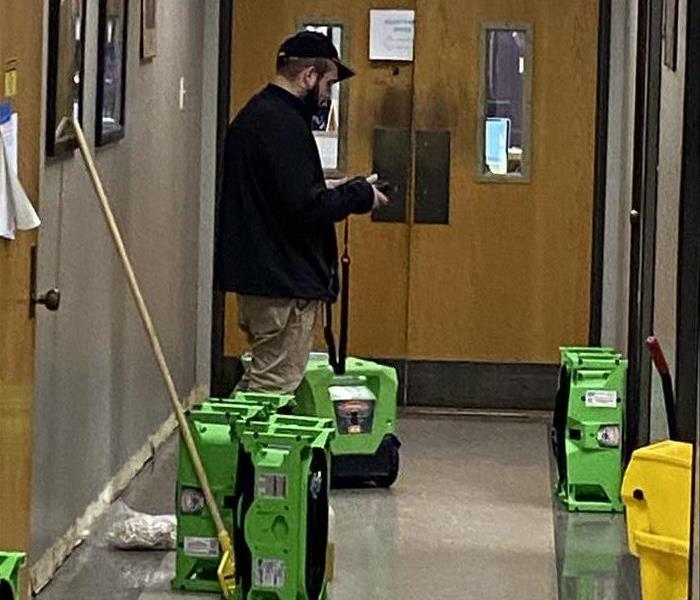 SERVPRO crew on a commercial job
SERVPRO crew on a commercial job
Water damage can be devastating for businesses, causing disruptions to operations, loss of inventory, and potential safety hazards for employees and customers. At SERVPRO, we understand the urgency of restoring your commercial property quickly and efficiently to minimize downtime and mitigate further damage. Here's how our commercial water restoration services can help safeguard your business:
Rapid Response: When water damage strikes your business, every minute counts. That's why SERVPRO offers a rapid response team available 24/7 to handle water emergencies of any size. Our trained professionals arrive promptly to assess the situation, mitigate the damage, and begin the restoration process immediately.
Advanced Equipment and Techniques: SERVPRO utilizes state-of-the-art equipment and advanced techniques to effectively remove water, dry affected areas, and restore your commercial property to pre-damage conditions. From powerful water extraction tools to industrial-grade dehumidifiers and air movers, we have the resources necessary to tackle even the most challenging water damage situations.
Comprehensive Restoration Services: Our commercial water restoration services encompass a wide range of solutions tailored to meet the unique needs of your business. Whether you're dealing with burst pipes, roof leaks, sewage backups, or flooding from severe weather, SERVPRO has the expertise and experience to handle it all.
Minimal Disruption: We understand the importance of minimizing disruption to your business operations during the restoration process. Our team works quickly and efficiently to restore your property while keeping downtime to a minimum, allowing you to get back to business as usual as soon as possible.
Thorough Documentation and Communication: Throughout the restoration process, SERVPRO provides thorough documentation of the damage, restoration efforts, and communication with your insurance company to streamline the claims process. We keep you informed every step of the way, ensuring transparency and peace of mind.
Don't let water damage jeopardize your business. Trust the experts at SERVPRO for fast, reliable commercial water restoration services. With our commitment to excellence and dedication to customer satisfaction, you can rest assured that your business is in good hands. Contact us today to learn more about how we can help protect your commercial property from water damage.
For more information Click Here
Expert Commercial Restoration Services: Trust SERVPRO® of Santa Rosa County
2/22/2024 (Permalink)
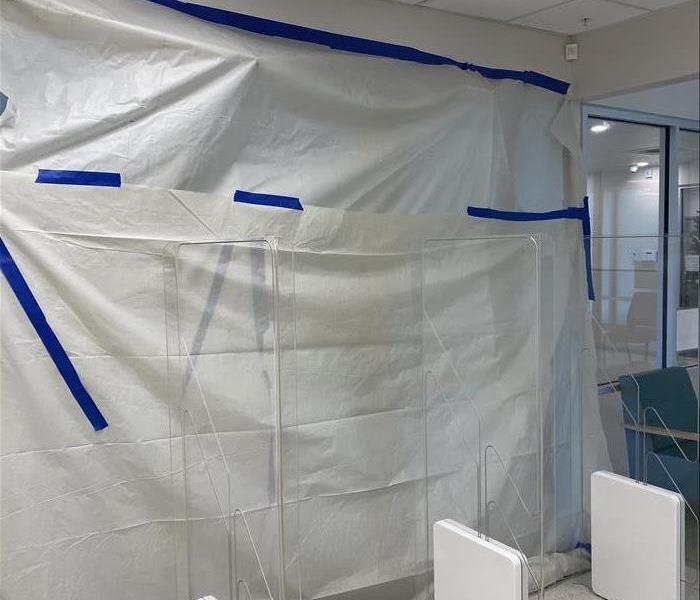 Commercial mold restoration being performed
Commercial mold restoration being performed
When disaster strikes your business, whether it's a fire, water damage, or mold infestation, quick and efficient restoration is essential to minimize downtime and get your operations back on track. At SERVPRO of Santa Rosa County, we understand the urgency of commercial restoration needs and are dedicated to providing top-notch services to businesses throughout the area.
Comprehensive Solutions for Businesses
Our team of highly trained professionals specializes in a wide range of commercial restoration services tailored to meet the unique needs of businesses across various industries. Whether you own a small retail shop, a large office complex, or a bustling restaurant, we have the expertise and resources to handle restoration projects of any size or complexity.
Prompt Response and 24/7 Availability
We recognize that emergencies can happen at any time, day or night. That's why we offer round-the-clock emergency services and swift response times to ensure that help is always just a phone call away. Our team is ready to mobilize quickly to assess the damage, develop a customized restoration plan, and begin the restoration process promptly, minimizing further damage and disruption to your business operations.
State-of-the-Art Equipment and Advanced Techniques
At SERVPRO® of Santa Rosa County, we utilize the latest technology and industry-leading equipment to deliver superior results efficiently and effectively. From advanced moisture detection tools to powerful extraction and drying equipment, we have everything needed to restore your property to preloss condition quickly.
Certified and Experienced Technicians
Our technicians undergo rigorous training and certification programs to ensure that they are equipped with the knowledge and skills necessary to handle even the most challenging restoration projects. With years of experience in the industry, you can trust our team to deliver exceptional results with professionalism and attention to detail.
Committed to Customer Satisfaction
Customer satisfaction is our top priority at SERVPRO® of Santa Rosa County. We understand the stress and disruption that commercial disasters can cause, and we are committed to providing compassionate, responsive service every step of the way. From initial assessment to final restoration, we work closely with our clients to address their needs and exceed their expectations.
Contact SERVPRO® of Santa Rosa County Today
When disaster strikes your business, trust the experts at SERVPRO of Santa Rosa County to provide reliable, efficient commercial restoration services. With our prompt response, advanced techniques, and unwavering commitment to customer satisfaction, we'll help you get back to business as usual in no time. Contact us today to learn more about our services or to schedule a consultation.
Navigating Fire Damage: What to Do After Your Home Sustains Fire Damage
2/10/2024 (Permalink)
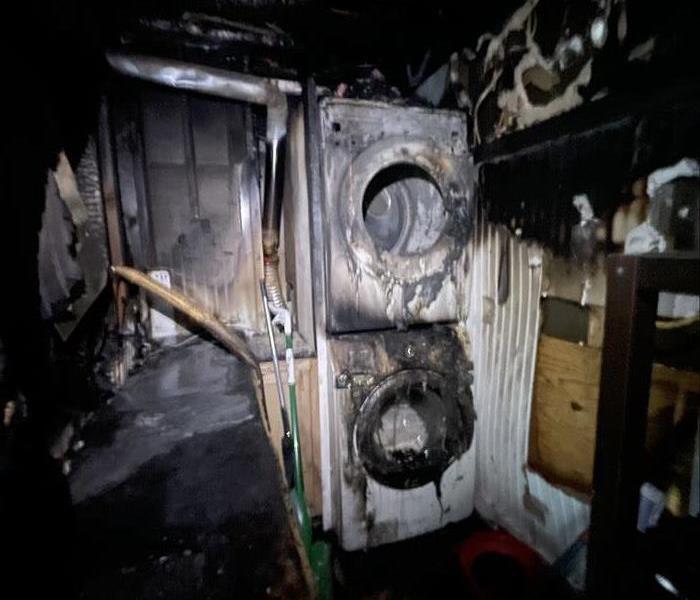 Completely burned out utility room.
Completely burned out utility room.
Experiencing a fire in your home can be a devastating and overwhelming situation. In the aftermath of a fire, it's crucial to take immediate action to ensure your safety and begin the restoration process. Here are the essential steps to take if your home in Santa Rosa County sustains fire damage:
Ensure Safety: Before re-entering your home, wait for authorities to confirm it is safe to do so. Be cautious of structural damage, electrical hazards, and lingering smoke or gas fumes. Wear appropriate personal protective equipment, such as gloves and a mask, to minimize exposure to soot and other contaminants.
Contact Your Insurance Company: Notify your insurance company as soon as possible to initiate the claims process. Provide detailed information about the extent of the damage and any valuable items that may have been affected. Your insurance provider can guide you through the necessary steps and coverage options for fire damage restoration.
Document the Damage: Take photographs or videos of the fire damage before beginning any cleanup or restoration efforts. Documenting the damage will serve as valuable evidence for your insurance claim and help restoration professionals assess the scope of work needed to restore your home.
Secure the Property: If your home has sustained structural damage or broken windows, take steps to secure the property to prevent further damage or unauthorized access. Board up windows, doors, and any openings to protect against weather elements and intruders.
Seek Professional Restoration Services: Fire damage restoration is a complex and specialized process that requires the expertise of trained professionals. Contact SERVPRO® of Santa Rosa County to assess the damage and develop a customized restoration plan. Our team of certified technicians will handle everything from debris removal and smoke odor removal to structural repairs and content restoration, restoring your home to its pre-fire condition efficiently and effectively.
Address Smoke Odor: Lingering smoke odor can permeate walls, furniture, and personal belongings, even after visible fire damage has been addressed. Our advanced deodorization techniques and equipment can effectively neutralize smoke odors and restore a fresh, clean scent to your home.
Consider Your Emotional Well-Being: Experiencing a fire can be traumatic, and it's essential to prioritize your emotional well-being during the recovery process. Lean on friends, family, and support networks for emotional support, and consider seeking professional counseling if needed.
Navigating the aftermath of a fire can be overwhelming, but with prompt action and the assistance of experienced professionals, you can begin the journey toward restoring your home and rebuilding your life. Trust SERVPRO of Santa Rosa County to be your partner in fire damage restoration, providing compassionate support and unparalleled expertise every step of the way.
Seasonal Home Health Care Tips from SERVPRO® of Santa Rosa County
1/27/2024 (Permalink)
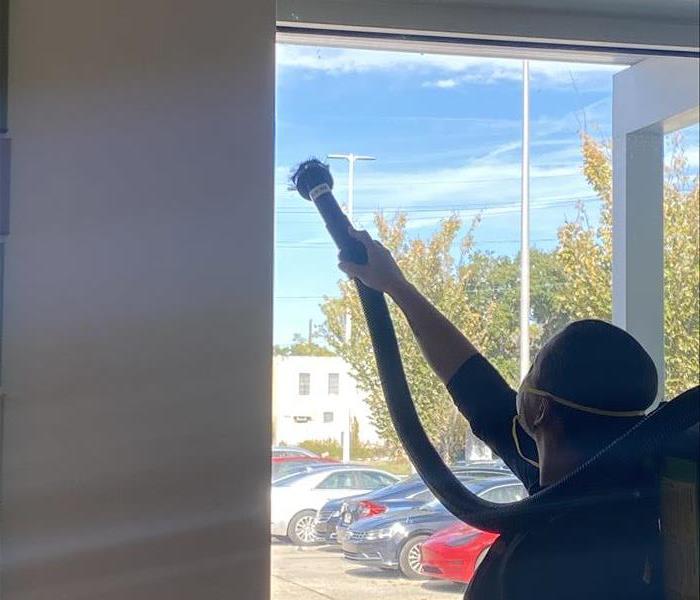 SERVPRO crew performing cleaning services
SERVPRO crew performing cleaning services
As the seasons change, so do the needs of your home. SERVPRO of Santa Rosa County cares about your property's well-being, and we're here to provide you with valuable seasonal home health care tips to keep your home in top shape throughout the year.
Spring: Renewal and Cleaning
Deep Clean: Spring is synonymous with cleaning. Take the time to deep clean your home, including dusting, vacuuming, and cleaning windows. Don't forget those often-neglected areas like baseboards and ceiling fans.
Inspect Your Roof: Winter weather may have taken a toll on your roof. Check for loose or damaged shingles and repair them promptly.
Landscaping: Trim trees and shrubs, remove dead branches, and clean up debris to prepare your yard for the growing season.
Summer: Energy Efficiency and Outdoor Maintenance
HVAC Maintenance: Schedule professional maintenance for your air conditioning system to ensure it runs efficiently during the hot summer months.
Gutter Cleaning: Clean gutters to prevent water damage and ensure proper drainage during summer storms.
Pool Care: If you have a pool, follow regular maintenance guidelines to keep it safe and enjoyable.
Fall: Preparation for Winter
Inspect Home Exterior: Examine your home's exterior for cracks or gaps in the siding, foundation, or windows. Seal any openings to prevent cold air from entering and warm air from escaping.
Heating System: Have your heating system professionally serviced before the winter season. Replace filters regularly to maintain indoor air quality.
Fireplace Safety: If you have a fireplace, ensure it's clean and in good working order. Consider scheduling a chimney inspection.
Winter: Cold Weather and Safety
Winterize Your Home: Insulate pipes to prevent freezing, and seal drafts around doors and windows. Maintain a warm and safe indoor environment.
Emergency Kit: Prepare an emergency kit with essentials like non-perishable food, blankets, flashlights, and a first-aid kit.
Holiday Safety: During the holiday season, be cautious with decorations and candles. Keep fire safety in mind, especially when using space heaters.
Year-Round: Regular Check-Ups
Smoke and Carbon Monoxide Detectors: Test smoke and carbon monoxide detectors monthly and replace batteries as needed.
Deep Cleaning: Periodically conduct a thorough cleaning to maintain a healthy indoor environment and prevent allergen buildup.
Emergency Plan: Create and practice a family emergency plan so everyone knows what to do in case of fire, severe weather, or other emergencies.
At SERVPRO of Santa Rosa County, we believe that a well-cared-for home is a happy and safe home. By following these seasonal home health care tips, you can ensure that your property remains a comfortable and secure haven throughout the year. Should any unexpected disasters, such as water damage or fire damage, affect your home, remember that SERVPRO is just a call away, ready to provide professional restoration and cleanup services.
Protecting Your Santa Rosa County Property from Cold Weather Pipe Damage
1/20/2024 (Permalink)
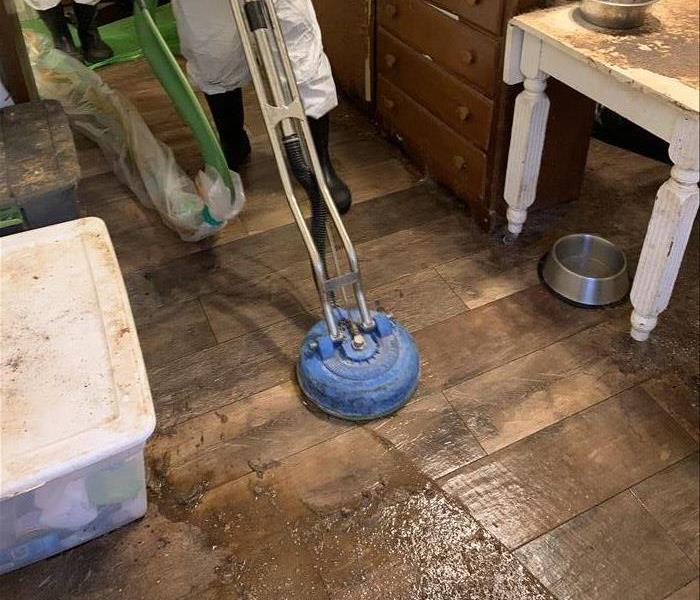 SERVPRO water damage restoration in progress
SERVPRO water damage restoration in progress
As residents of Santa Rosa County, we're fortunate to enjoy a generally mild climate. However, occasional cold spells can still occur during the winter months, and it's crucial to be prepared for the possibility of cold weather pipe damage. This guide from SERVPRO® is tailored to our community, providing insights on how to safeguard your Santa Rosa County property.
Understanding Cold Weather Pipe Damage: Cold weather pipe damage happens when water within pipes freezes, causing them to expand and potentially burst. This can result in substantial water damage within your home or business. While our region generally experiences milder winters, it's essential to stay vigilant.
Preventive Measures for Santa Rosa County:
Insulate Your Pipes: Properly insulate all exposed pipes, especially those in unheated areas like basements, attics, and crawl spaces. Insulation acts as a protective barrier against the cold.
Seal Gaps and Cracks: Seal any gaps or cracks in your property's walls, foundation, or around pipes to prevent cold drafts from entering. This helps maintain a consistent indoor temperature.
Disconnect Hoses: Before winter arrives, disconnect and drain garden hoses. Leaving them attached can trap water, increasing the risk of pipe damage.
Drip Your Faucets: During severe cold snaps, let faucets drip slowly to keep water flowing. This reduces pressure within the pipes and helps prevent freezing.
Keep Interior Doors Open: Promote warm air circulation throughout your property by keeping interior doors open, especially in areas with plumbing.
What to Do If You Suspect Frozen Pipes:
Turn Off Water Supply: If you suspect frozen pipes, immediately shut off the water supply to your Santa Rosa County property. This can help prevent further damage when the pipes thaw.
Thaw Pipes Safely: Use a heat source such as a hair dryer or heat lamp to gently thaw frozen pipes. Avoid open flames or excessive heat, as these can harm the pipes.
Consult a Professional: If you're uncertain about how to thaw pipes or if a pipe has burst, it's advisable to contact a professional plumber. They can assess the situation and perform necessary repairs.
Water Damage Mitigation in Santa Rosa County: Should you experience pipe damage and water intrusion, swift action is crucial:
Shut Off the Water: Immediately turn off the main water supply to prevent further flooding.
Call SERVPRO: Reach out to our skilled team at SERVPRO of Santa Rosa County. We specialize in water damage restoration and can promptly respond to minimize damage.
Document the Damage: Document the affected areas through photos or videos for insurance purposes.
Commence Cleanup: Begin the cleanup process by removing excess water with towels or a wet/dry vacuum. Ensure proper ventilation to facilitate drying.
While Santa Rosa County enjoys a relatively mild climate, it's essential to be prepared for the possibility of cold weather pipe damage. Taking preventive measures and knowing how to respond can save you time, money, and stress. Should you ever encounter water damage issues, remember that SERVPRO is here to provide professional assistance in restoring your Santa Rosa County property.
Why SERVPRO® is Your Trusted Partner for Commercial Water Restoration in Santa Rosa County
1/7/2024 (Permalink)
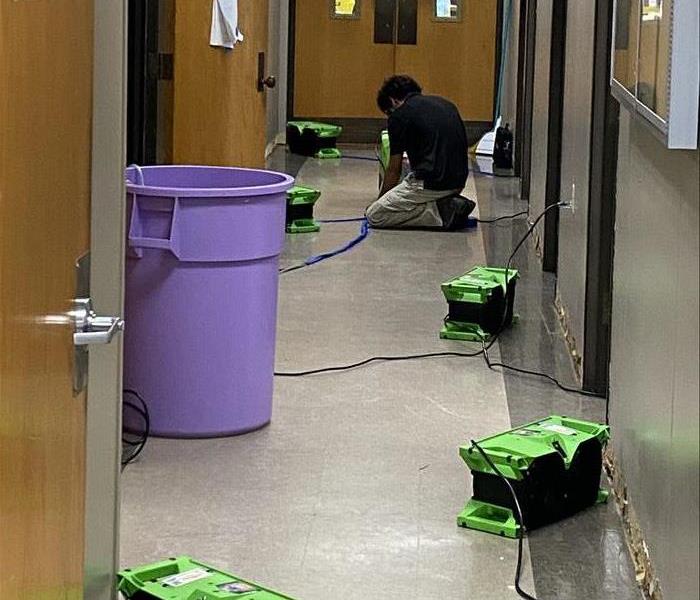 SERVPRO crew member deploying drying equipment
SERVPRO crew member deploying drying equipment
Water damage in a commercial property can be a complex and challenging issue to address. Whether it's a burst pipe, flooding, or roof leaks, the consequences can disrupt your business operations and lead to financial losses. In Santa Rosa County, when you face such a crisis, you need a trusted partner who can handle any commercial water restoration needs. That partner is SERVPRO®. Here's why you can rely on us:
1. Extensive Experience:
- With decades of experience in the restoration industry, SERVPRO® has encountered and successfully addressed a wide range of commercial water damage scenarios.
- Our skilled technicians understand the unique challenges that businesses face and are well-equipped to provide effective solutions.
2. 24/7 Availability:
- Water emergencies don't follow a schedule, and neither do we. SERVPRO® offers round-the-clock emergency services, ensuring that we're available whenever disaster strikes.
- Our swift response minimizes downtime and helps you get back to business as usual as quickly as possible.
3. Advanced Equipment:
- We utilize state-of-the-art equipment and technology designed for commercial water restoration.
- Our powerful extraction units, dehumidifiers, air movers, and moisture-detecting tools enable us to efficiently and thoroughly address water damage, regardless of scale.
4. Comprehensive Services:
- SERVPRO® offers a full spectrum of commercial restoration services. Whether you're dealing with water damage, fire damage, mold infestations, or biohazard cleanup, we have the expertise to handle it all.
- Our one-stop approach streamlines the restoration process, reducing the need for multiple contractors and ensuring a smoother recovery.
5. Minimized Disruption:
- We understand that minimizing disruption to your business is a top priority. SERVPRO® works diligently to complete the restoration process swiftly and efficiently.
- Our goal is to get you back in business while adhering to the highest quality standards.
6. Industry Certification:
- SERVPRO® technicians are certified by the Institute of Inspection, Cleaning and Restoration Certification (IICRC). This certification ensures that our team is well-trained and knowledgeable in the latest industry standards and best practices.
7. Customized Solutions:
- We recognize that each commercial property is unique. SERVPRO® tailors its restoration approach to your specific needs, ensuring a personalized and effective solution.
8. Insurance Coordination:
- Dealing with insurance claims can be overwhelming. SERVPRO® can work directly with your insurance company to facilitate the claims process, providing you with peace of mind.
In Santa Rosa County, when your commercial property faces water damage, you can trust SERVPRO® to handle any restoration needs with professionalism, efficiency, and expertise. We're committed to helping local businesses recover from water damage and get back to serving the community. Don't hesitate to call us for all your commercial water restoration needs.
For more information on hazards of water damage Click Here
Rapid Water Damage Restoration for Property Rentals by SERVPRO®
12/29/2023 (Permalink)
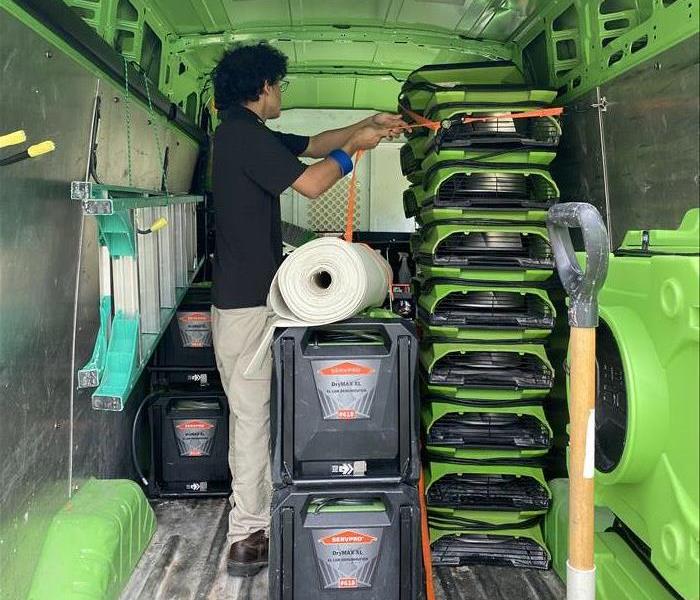 SERVPRO equipment
SERVPRO equipment
Water damage can be a nightmare for property owners, especially when it forces you to shut down your rental property. Whether it's due to a burst pipe, flooding, or any other water-related incident, the impact on your rental business can be significant. Fortunately, SERVPRO® is here to help get your property back on track quickly and efficiently.
The Impact of Water Damage on Rental Properties:
Loss of Rental Income: When water damage occurs, it often necessitates repairs and restoration, leading to a loss of rental income during the downtime.
Property Damage: Water damage can cause structural damage, affecting the integrity of your property and its value.
Tenant Displacement: Your tenants may need to vacate the property temporarily, leading to inconvenience and potential lease issues.
Mold Growth: If not addressed promptly, water damage can lead to mold growth, creating health hazards and further damage.
How SERVPRO® Can Help:
Rapid Response: SERVPRO® understands the urgency of water damage situations. Our 24/7 emergency response ensures a swift arrival at your property to assess the damage and initiate restoration.
Efficient Water Extraction: We use industrial-grade pumps and vacuums to extract standing water quickly, preventing further damage.
Advanced Drying Techniques: Our team employs advanced drying techniques, including high-capacity dehumidifiers and air movers, to thoroughly dry the affected areas and prevent mold growth.
Mold Prevention: We take proactive measures to prevent mold growth and, if necessary, provide mold remediation services.
Content Restoration: SERVPRO® offers content restoration services to salvage and restore belongings affected by water damage whenever possible.
Repairs and Reconstruction: We can handle necessary repairs and reconstruction, ensuring your rental property is restored to its pre-damage condition.
Insurance Coordination: We work with your insurance company to streamline the claims process, minimizing your stress and ensuring a smoother experience.
Getting Back on Track:
At SERVPRO®, we understand that time is of the essence when it comes to rental properties. Our goal is to minimize downtime and get your property back on track as quickly as possible. With our expertise, advanced equipment, and commitment to efficient restoration, you can trust us to help you navigate the challenges of water damage and ensure your rental business thrives.
If water damage has disrupted your rental property, don't hesitate to call SERVPRO®. We're here to provide rapid and reliable water damage restoration services, allowing you to reopen your property for tenants and resume rental income. Trust SERVPRO® for all your property restoration needs, and let us help you get back to business.
For more information on hazards from water damage Click Here

 24/7 Emergency Service
24/7 Emergency Service
